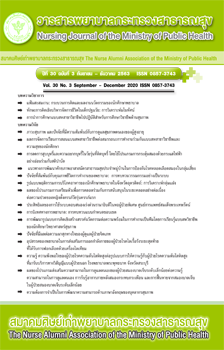Guidelines for Potential Development of Village Health Volunteers (o Prevent Stroke in a Risk Group
Main Article Content
Abstract
This action research was conducted to investigate and to develop guidelines and outcomes of potential development of village health volunteers (VHVs) to prevent stroke. The research study consisted of 53 participants which consisted of 30 VHVs, a registered nurse, a public health and environment officer, a community leader and 20 of people with a risk of stroke. The study was conducted in a village in Nakhon Ratchasima province. Data were collected through in-depth interviews, a focus group, and participatory observations. Data were analyzed using content analysis. The results showed that the VHVs have an inadequate knowledge of stroke. There was a lack of available teaching media during home visits for at-risk patients. Patients were more inclined to trust the advice from health officers than they were from village health volunteers. There was no consistent and regular communication from the community informing the villagers about stroke. Strategies for the potential development of village health volunteers for the prevention of stroke uses the participation of the volunteers and stakeholders. These strategies included studying the problem, analyzing the data, returning the data, planning, acting, and evaluating. The action plan consisted of 1) organizing a seminar on stroke and the roles of village health volunteers, 2) establishing a family visiting team, 3) developing a stroke leader, and 4) creating teaching media for stroke. This research found that village health volunteers had more knowledge and felt more confident in preventing strokes. They had guidelines for home visits. Also, people with a high risk of stroke also received more benefits from these volunteers so as to apply this knowledge for improved self-care.
Article Details
บทความและรายงานวิจัยในวารสารพยาบาลกระทรวงสาธารณสุข เป็นความคิดเห็นของ ผู้เขียน มิใช่ของคณะผู้จัดทำ และมิใช่ความรับผิดชอบของสมาคมศิษย์เก่าพยาบาลกระทรวงสาธารณสุข ซึ่งสามารถนำไปอ้างอิงได้
References
2. Nakhon Ratchasima Provincial Health Office. Health service usage information. [internet]. Nakhon Ratchasima: Nakhon Ratchasima Provincial Health Office;2019 [cited 2019 Jan 15]. Available from: http://nma.hdc.moph.go.th/hdc/main/index_pk.php-2019/thai/
3. Jutarosaga M, Kaewon S, Sansuk J. Training curriculum development for village health volunteer using systems thinking process and humanized health care concept. Journal of Nurses’ Association of Thailand, North-Eastern Division. 2013;31(1):177-83. (in Thai)
4. Department of Health Service Support. Modern village health volunteers handbook. Bangkok: The Agricultural Co-operative Federation of Thailand.,LTD;2011.
5. Anunta P, Tonganake J. The effectiveness of home visit and training program in village health volunteers in Khwao, Selaphum, Roi Et.2012. Journal of the office of DPC 7 Khon Kaen. 2013;20(1):1-8. (in Thai)
6. Sinpai W, Kompor P. Potential development of village health volunteers on high blood pressure prevention and control at Ban Nangew Moo1, 7 Nangew Sub-District Sangkom District Nongkhai Province. KKU Journal for Public Health Research 2013;6(3):85-92. (in Thai)
7. Jitbantad W, Ruangput P, Sahairak S, Warapeang W. Capacity building of community volunteers to be case manager of community dwelling elderly with disabilities. Health Systems Research Institute (HSRI) [internet].2017 [cited 2019 Dec 20]. Available from: http://164.115.27.97/digital/files/original/20ce4052fd8df6b3296c0eb82ccd850b.pdf
8. Lewin K. Action research and minority problems. Journal of Social Issues.1946;2(4):34-46.
9. Chantavanich S. Data analysis in qualitative research. 12th ed. Bangkok: Chulalongkorn University;2016. (in Thai)
10. Phothisita C. The science and arts of qualitative research. 7th ed. Bangkok: Ammarin Printing and Phaplitching Chamkat (Mahachon);2016. (in Thai)
11. Daymon C, Holloway IM. Qualitative research methods in public relations and marketing communications. 2nd ed. Newyork: Routledge;2011.
12. Phinyo P, Phinyo K, Limtragool P, Tiamkao S, Worawong C, Chuasuan W, et al. Care improvement for patients with stroke through community participation. Songklanagerind Journal of Nursing. 2015;35(2):93-111. (in Thai)
13. Hnuploy K. Factors relating to village health volunteer performance, Phatthalung Province. [Master thesis].Songkla: Thaksin University;2010. (In Thai)
14. Stringer ET. Action Research. 4th ed. Los Angeles: Sage Publication;2014.
15. Phromwet S. The result of potential development program of village health volunteers to promote elderly’s health in Nongsung subdistrict, Aranyaprathet district, Sakaeo province. [Master thesis]. Chachoengsa:Rajabhat Rajanagarindra University;2016. (in Thai)
16. Nilvarangkul K. Action research and participatory action research: background and connection. Journal of Nurses’ Association of Thailand, North-Eastern Division 2013; 31(3):23-8. (In Thai)

